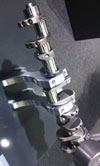Applying Matinaglia's good advice
 In the author's article on the mitigation of stress concentration in critical areas of crankshafts last month (Crankshafts: Stress-concentration mitigation), we mentioned the 1943 paper by Matinaglia. Some of his findings are repeated in the books by C.F. Taylor, which, if you don't have a copy of these, you would do well to avail yourself of. The paper by Matinaglia is worth reading but, having been published many decades ago in a trade journal, is not easy to get sight of.
In the author's article on the mitigation of stress concentration in critical areas of crankshafts last month (Crankshafts: Stress-concentration mitigation), we mentioned the 1943 paper by Matinaglia. Some of his findings are repeated in the books by C.F. Taylor, which, if you don't have a copy of these, you would do well to avail yourself of. The paper by Matinaglia is worth reading but, having been published many decades ago in a trade journal, is not easy to get sight of.
The crankshaft which I mentioned, from the Mercedes SSK, was physically very large and of sufficiently large throw to allow much of the material removal for lightweight and mitigation of stress concentration to be removed by means of machining, although it is almost certain that the 'blank' or 'rough' crankshaft was originally cast.
Certainly, we would struggle to provide such elegant design features in many of our modern racing engines, especially where short-stroke designs have been favoured in the search for ever-increasing engine speeds as we chase higher output. The room for machine tool access is simply not available, and where it is available, we may struggle owing to lack of rigidity in the tooling. Some other modern methods of material removal may prove to be a little more fruitful in this respect, although practices such as spark erosion still require a certain amount of access and, whilst they don't suffer the same problems as machining due to lack of rigidity, they can have their own problems.
So, do we have to discount Matinaglia's good advice, and the results of his excellent research and experiment? Well, that would depend on our available budget, our knowledge of manufacturing processes, and our willingness to think of the possibilities. In the press rumours abound that some Formula One engine manufacturers had looked at hollow crankshafts several years ago, and the anecdotal evidence is strong enough to believe that it has more than a grain of truth to it. The gains to be had are sufficiently large in terms of reduced inertia (if reduced inertia is indeed your goal) and mass that it is almost inconceivable to think that this hadn't been considered. These gains alone are clearly worthwhile, but if we consider that these low mass components may come with an attendant benefit of lower critical stress, it makes the case for such research compelling.
In my previous employment with one Formula One engine manufacturer I made proposals about the manufacture of hollow crankshafts, and I had arrived at a workable solution in terms of manufacturing techniques before the project was shelved, owing to forthcoming regulation changes and requirements for homologation of engine designs. There are a number of feasible solutions to providing a hollow crankshaft using a number of commonly-used industrial techniques, although many of these techniques aren't widely used in motorsport.
At the moment, we commonly hollow crankpins, both to save mass and to mitigate stress concentration (as seen in the accompanying picture of the Peugeot V10 Formula One crankshaft), however, we rarely see anything which goes further toward the goal of a hollow crankshaft.
However, for those working in an environment where rules don't shackle engineering excessively, with a development budget, an enquiring and creative mind, and a good knowledge of manufacturing techniques, the possibility remains to create a crankshaft with hollow mains and crankpins. Perhaps Matinaglia's work for the mighty Sulzer won't remain only as an interesting technical dead-end as far as racing is concerned.
Fig. 1 - A hollow crankshaft - a technical dead-end?
Written by Wayne Ward